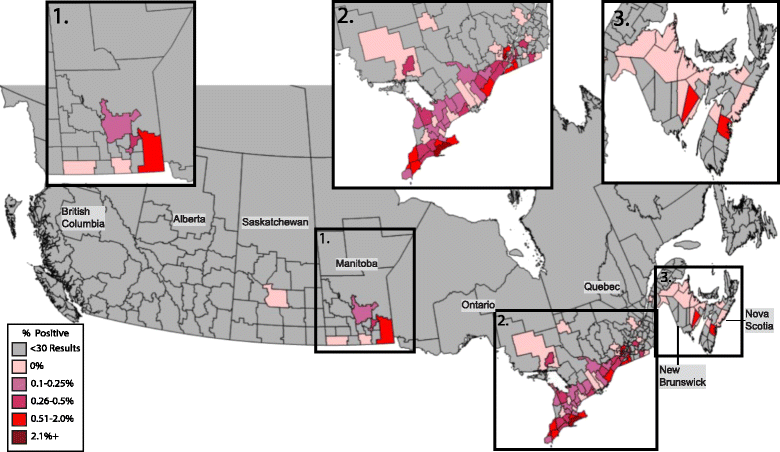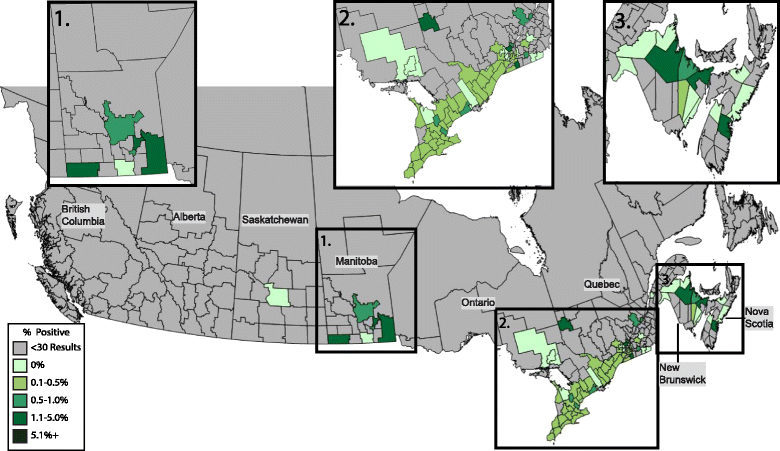Canine infection with Borrelia burgdorferi, Dirofilaria immitis, Anaplasma spp. and Ehrlichia spp. in Canada, 2013-2014
- PMID: 28526093
- PMCID: PMC5437676
- DOI: 10.1186/s13071-017-2184-7
Canine infection with Borrelia burgdorferi, Dirofilaria immitis, Anaplasma spp. and Ehrlichia spp. in Canada, 2013-2014
Abstract
Background: Canine test results generated by veterinarians throughout Canada from 2013-2014 were evaluated to assess the geographical distribution of canine infection with Borrelia burgdorferi, Dirofilaria immitis, Ehrlichia spp., and Anaplasma spp.
Methods: The percent positive test results of 115,636 SNAP® 4Dx® Plus tests from dogs tested were collated by province and municipality to determine the distribution of these vector-borne infections in Canada.
Results: A total of 2,844/115,636 (2.5%) dogs tested positive for antibody to B. burgdorferi. In contrast, positive test results for D. immitis antigen and antibodies to Ehrlichia spp. and Anaplasma spp. were low, with less than 0.5% of dogs testing positive for any one of these three agents nationwide. Provincial seroprevalence for antibodies to B. burgdorferi ranged from 0.5% (Saskatchewan)-15.7% (Nova Scotia); the areas of highest percent positive test results were in proximity to regions in the USA considered endemic for Lyme borreliosis, including Nova Scotia (15.7%) and Eastern Ontario (5.1%). These high endemic foci, which had significantly higher percent positive test results than the rest of the nation (P < 0.0001), were surrounded by areas of moderate to low seroprevalence in New Brunswick (3.7%), Quebec (2.8%), and the rest of Ontario (0.9%), as well as northward and westward through Manitoba (2.4%) and Saskatchewan (0.5%). Insufficient results were available from the westernmost provinces, including Alberta and British Columbia, to allow analysis.
Conclusion: Increased surveillance of these vector-borne disease agents, especially B. burgdorferi, is important as climate, vector range, and habitat continues to change throughout Canada. Using dogs as sentinels for these pathogens can aid in recognition of the public and veterinary health threat that each pose.
Keywords: Anaplasma; Borrelia burgdorferi; Canada; Canine; Dirofilaria immitis; Ehrlichia.
Figures




Similar articles
-
Prevalence of Borrelia burgdorferi, Anaplasma spp., Ehrlichia spp. and Dirofilaria immitis in Canadian dogs, 2008 to 2015: a repeat cross-sectional study.Parasit Vectors. 2019 Jan 28;12(1):64. doi: 10.1186/s13071-019-3299-9. Parasit Vectors. 2019. PMID: 30691522 Free PMC article.
-
Canine infection with Dirofilaria immitis, Borrelia burgdorferi, Anaplasma spp., and Ehrlichia spp. in the United States, 2013-2019.Parasit Vectors. 2021 Jan 6;14(1):10. doi: 10.1186/s13071-020-04514-3. Parasit Vectors. 2021. PMID: 33407758 Free PMC article.
-
Serological detection of antibodies to Anaplasma spp., Borrelia burgdorferi sensu lato and Ehrlichia canis and of Dirofilaria immitis antigen in dogs from Costa Rica.Vet Parasitol. 2017 Mar 15;236:97-107. doi: 10.1016/j.vetpar.2017.02.009. Epub 2017 Feb 14. Vet Parasitol. 2017. PMID: 28288773
-
Ehrlichiosis and Anaplasmosis: An Update.Vet Clin North Am Small Anim Pract. 2022 Nov;52(6):1225-1266. doi: 10.1016/j.cvsm.2022.07.002. Vet Clin North Am Small Anim Pract. 2022. PMID: 36336419 Review.
-
ACVIM small animal consensus statement on Lyme disease in dogs: diagnosis, treatment, and prevention.J Vet Intern Med. 2006 Mar-Apr;20(2):422-34. doi: 10.1892/0891-6640(2006)20[422:asacso]2.0.co;2. J Vet Intern Med. 2006. PMID: 16594606
Cited by
-
Serological survey of canine vector-borne diseases in Saskatchewan, Canada.Can Vet J. 2018 Oct;59(10):1109-1111. Can Vet J. 2018. PMID: 30510318 Free PMC article.
-
Canine and human infection with Borrelia burgdorferi in the New York City metropolitan area.Parasit Vectors. 2018 Mar 20;11(1):187. doi: 10.1186/s13071-018-2774-z. Parasit Vectors. 2018. PMID: 29554949 Free PMC article.
-
Defining important canine zoonotic pathogens within the Prairie Provinces of Canada.Can Vet J. 2021 May;62(5):477-483. Can Vet J. 2021. PMID: 33967286 Free PMC article. Review.
-
Under-Detection of Lyme Disease in Canada.Healthcare (Basel). 2018 Oct 15;6(4):125. doi: 10.3390/healthcare6040125. Healthcare (Basel). 2018. PMID: 30326576 Free PMC article.
-
The Invasive Mosquitoes of Canada: An Entomological, Medical, and Veterinary Review.Am J Trop Med Hyg. 2022 Jul 11;107(2):231-244. doi: 10.4269/ajtmh.21-0167. Print 2022 Aug 17. Am J Trop Med Hyg. 2022. PMID: 35895394 Free PMC article. Review.
References
-
- Simon JA, Marrotte RR, Desorsiers N, Fiset J, Gaitan J, et al. Climate change and habitat fragmentation drive the occurrence of Borrelia burgdorferi, the agent of Lyme disease, at the northeastern limit of its distribution. Evolut Appl. 2014;7(7):750–764. doi: 10.1111/eva.12165. - DOI - PMC - PubMed
-
- Bowman DD, Little SE, Lorentzen L, Shields J, Sulivan MP, Carlin EP. Prevalence and geographic distribution of Dirofilaria immitis, Borrelia burgdorferi, Ehrlichia canis, and Anaplasma phagocytophilum in dogs in the United States: results of a national clinic-based serologic survey. Vet Parasitol. 2009;160(1–2):138–148. doi: 10.1016/j.vetpar.2008.10.093. - DOI - PubMed
MeSH terms
Substances
LinkOut - more resources
Full Text Sources
Other Literature Sources
Medical
Miscellaneous

